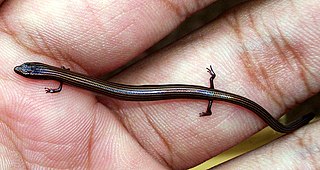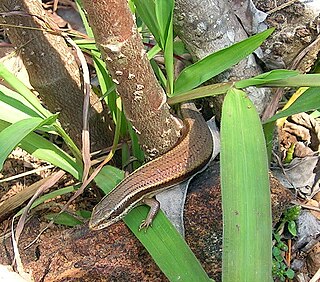
Skinks are lizards belonging to the family Scincidae, a family in the infraorder Scincomorpha. With more than 1,500 described species across 100 different taxonomic genera, the family Scincidae is one of the most diverse families of lizards. Skinks are characterized by their smaller legs in comparison to typical lizards and are mostly found in different habitats except arctic and subarctic regions.

Lygosoma is a genus of lizards, commonly known as supple skinks or writhing skinks, which are members of the family Scincidae. Lygosoma is the type genus of the subfamily Lygosominae.

Riopa is a genus of skinks. It is easy to tell the species apart from most other skinks by bright red coloring on their sides from which they get their name. They also have a bule that runs down the side of their tail.
The white-spotted supple skink is a species of diurnal, terrestrial, insectivorous skink found in parts of tropical Asia. This species was first described by John Edward Gray based on type specimen collected by T. C. Jerdon from Madras, in the Coromandel Coast of South India.
Riopa goaensis is a species of skink found in India.

Riopa guentheri, commonly known as Günther's supple skink or Günther's writhing skink, is a species of skink, which is endemic to India.

Riopa lineata, the lined writhing skink or lined supple skink, is a species of writhing skink. It is known from India, Bangladesh and Myanmar. This skink grows to about 6 cm in length. The body colouration is golden and each scale has a black dot forming longitudinal stripes on the body. It is known to occur from Gujarat to north of Karnataka. In Mumbai this skink has been observed in the Sanjay Gandhi National Park and Aarey milk colony. It is often found under rocks, loose soil associated with termite mounds and ant hills. It is crepuscular. A captive individual accepted termites, mosquito, house flies, ant eggs for about 45 days and was released.
Subdoluseps pruthi, known commonly as Pruthi's skink or Pruthi's supple skink, is a species of diurnal, terrestrial, insectivorous, lizard in the family Scincidae. The species is endemic to the southern part of the Eastern Ghats in South India. The species was first described based on the type specimen from Chitteri hills in Dharmapuri district of Tamil Nadu. Further surveys reveal the presence of similar-looking skinks in nearby hill ranges. Though described in 1977, the holotype was collected in 1929, and yet very little is known or has been published about this species.
Vosmer's writhing skink is a species of skink, a lizard in the family Scincidae. The species is endemic to India.

The banded supple skink, also known commonly as Harold's writhing skink or Harold Young's supple skink, is a species of skink, a lizard in the family Scincidae. The species is endemic to Southeast Asia.
Carinascincus palfreymani, known commonly as the Pedra Branca skink, as well as the Palfreyman's window-eyed skink, the Pedra Branca cool-skink, or the red-throated skink, is a species of skink in the family Scincidae. The species is endemic to Australia, and is restricted to the windswept Pedra Branca, an island off southern Tasmania of only 2.5 ha, where it is dependent on the seabird colonies. It is the only lizard species found on the island.

Lygosominae is the largest subfamily of skinks in the family Scincidae. The subfamily can be divided into a number of genus groups. If the rarely used taxonomic rank of infrafamily is employed, the genus groups would be designated as such, but such a move would require a formal description according to the ICZN standards.

Carinascincus metallicus, the metallic cool-skink or metallic skink is a species of skink in the family Scincidae. It is endemic to Australia, found in southern Victoria, as well as in Tasmania where it is the most widespread and common lizard, occurring on many offshore islands in Bass Strait as well as the mainland. It gives birth to live young. It is highly variable in colour and pattern, and may be a complex of closely related species.

Bougainville's skink is a species of skink, a lizard in the family Scincidae. This species is also commonly called the south-eastern slider and Bougainville's lerista.

The fire skink, also known as the true fire skink or Togo fire skink, is a fairly large skink, a species of lizard in the family Scincidae. The species is known for its bright and vivid coloration. Native to tropical forests in Western Africa, the fire skink lives fifteen to twenty years. This species is a diurnal lizard that loves to burrow and hide. It is relatively shy and reclusive, but may become tame in captivity.
Lygosoma boehmei is a species of skink, a lizard in the family Scincidae. The species is endemic to Vietnam.
Angel's writhing skink is a species of lizard in the family Scincidae. The species is native to Southeast Asia.

Riopa anguina is a species of skink found in Myanmar and Thailand.
The striped writhing skink is a species of skink found in Myanmar and Bangladesh.
Mochlus tanae, also known commonly as Loveridge's writhing skink or the Tana River writhing skink, is a species of lizard in the family Scincidae. The species is native to East Africa.










